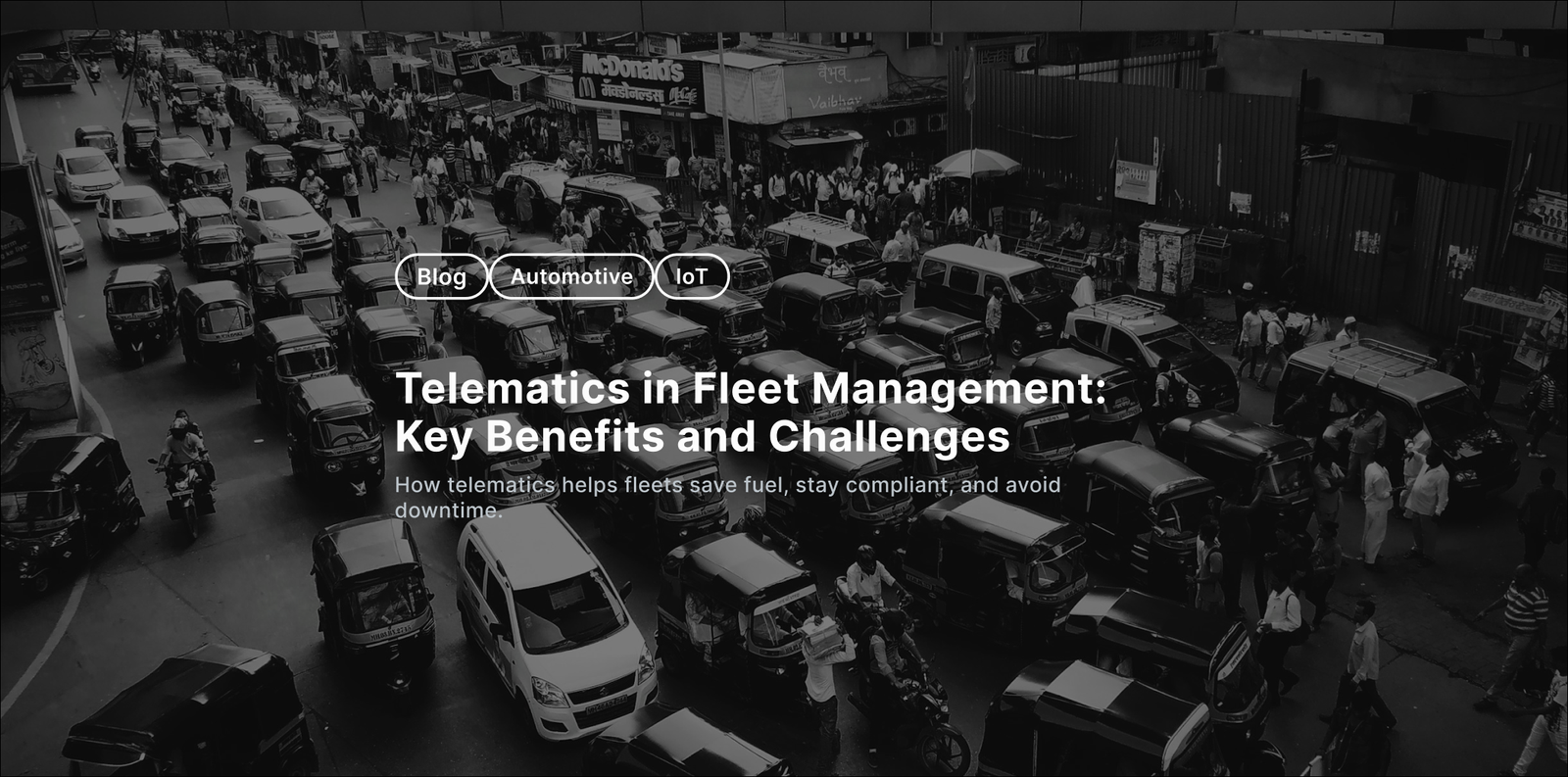✆ + 1-646-235-9076 ⏱ Mon - Fri: 24h/day
Telematics in Fleet Management: Key Benefits and Challenges


In recent years, telematics has moved from being a promising innovation to a core component of modern fleet management. With the growing need for operational efficiency, safety, and compliance, telematics offers businesses a way to bridge the gap between real-time data and actionable decision-making. Yet, like any technological shift, its adoption comes with both advantages and challenges that organizations must navigate thoughtfully.
What Is Telematics?
Telematics combines telecommunications and informatics to monitor vehicles, assets, and drivers in real time. At its core, a telematics system collects data via onboard devices (typically through OBD-II ports or built-in vehicle systems), processes this data using software, and provides insights through a centralized dashboard or API.
Typical data points include:
- GPS location and route history
- Vehicle speed, idle time, fuel usage
- Engine diagnostics and fault codes
- Driver behavior metrics (e.g., harsh braking, acceleration)
- Maintenance schedules and alerts
These insights enable data-driven decisions in fleet operations, logistics, and compliance management.
Key Benefits of Telematics in Fleet Management
1. Real-Time Tracking & Route Optimization
Real-time GPS tracking allows fleet managers to monitor the exact location of every vehicle. This visibility helps improve route planning, reduce delays, and respond quickly to incidents. Advanced telematics platforms can integrate with traffic data to suggest alternate routes, reducing idle time and ensuring timely deliveries.
2. Fuel Efficiency and Cost Savings
Fuel remains one of the highest operating costs for fleets. Telematics enables monitoring of fuel consumption patterns, identifies inefficient routes, and flags behaviors like idling or aggressive driving that increase fuel burn. Companies using telematics have reported fuel savings of up to 15–20% through improved driving habits and route optimization.
3. Preventive Maintenance & Vehicle Health Monitoring
Telematics systems continuously collect data from vehicle engines and systems, detecting potential mechanical issues before they become costly breakdowns. Automatic alerts based on engine fault codes or mileage help schedule maintenance proactively, extending vehicle lifespan and reducing downtime.
4. Enhanced Driver Safety and Behavior Monitoring
Driver behavior analytics allow companies to identify risky patterns such as speeding, harsh braking, or rapid acceleration. Many platforms offer driver scorecards and coaching tools, fostering a culture of accountability and safety. According to industry studies, fleets that implement driver monitoring experience up to 30% fewer accidents.
5. Regulatory Compliance
In markets like the U.S., telematics plays a crucial role in compliance with mandates such as the ELD (Electronic Logging Device) requirement for hours-of-service tracking. Automated logbooks reduce paperwork errors and ensure adherence to legal driving limits, helping avoid penalties.
6. Operational Transparency and Better Decision-Making
Centralized dashboards offer a complete view of fleet operations, allowing managers to make informed decisions faster. Whether it’s reallocating assets, adjusting schedules, or identifying underutilized vehicles, data visibility translates to agility and cost-efficiency.
Challenges in Adopting Telematics
Despite the clear benefits, adopting telematics is not without its complexities.
1. Initial Implementation Costs
Upfront investment in hardware, software licensing, and system integration can be a barrier, especially for small and mid-sized fleets. Although ROI is typically seen within the first year, cost concerns can slow down adoption.
2. Data Privacy and Security
With vast amounts of vehicle and driver data collected, data privacy becomes a key concern. Companies must ensure compliance with GDPR and local data protection laws, establish access controls, and work with vendors that prioritize cybersecurity.
3. Driver Resistance and Change Management
Some drivers may view telematics as intrusive or a tool for micromanagement. Effective change management—through transparency, training, and involving drivers in the process—is crucial for successful adoption.
4. Integration with Legacy Systems
Integrating telematics with existing ERP, TMS (transportation management systems), or maintenance software can be technically challenging. Companies should evaluate system compatibility early in the selection process to avoid costly delays later.
5. Data Overload
While access to real-time data is a strength, it can also become overwhelming without the right filtering and analytics. Choosing a platform that prioritizes actionable insights over raw data is essential to avoid analysis paralysis.
Best Practices for Successful Telematics Implementation
- Start with clear objectives: Define specific KPIs such as fuel savings, reduction in accidents, or maintenance cost reduction.
- Choose scalable solutions: Opt for telematics platforms that can grow with your fleet and support future integrations.
- Involve drivers early: Address concerns, provide training, and show how telematics benefits them too—especially through incentives tied to safe driving.
- Prioritize data security: Ensure compliance with data protection regulations and choose providers with strong cybersecurity practices.
Review and adapt: Telematics is not a one-time setup. Regularly review the data, adapt strategies, and iterate.
Conclusion
Telematics is reshaping how fleets are managed, offering both strategic and operational value. While implementation can present hurdles, the long-term benefits, ranging from cost reduction to enhanced safety and compliance, make it a worthwhile investment for forward-thinking fleet operators.
As the industry moves toward greater digitization, telematics is no longer optional. It’s the foundation for smarter, safer, and more sustainable fleet management.